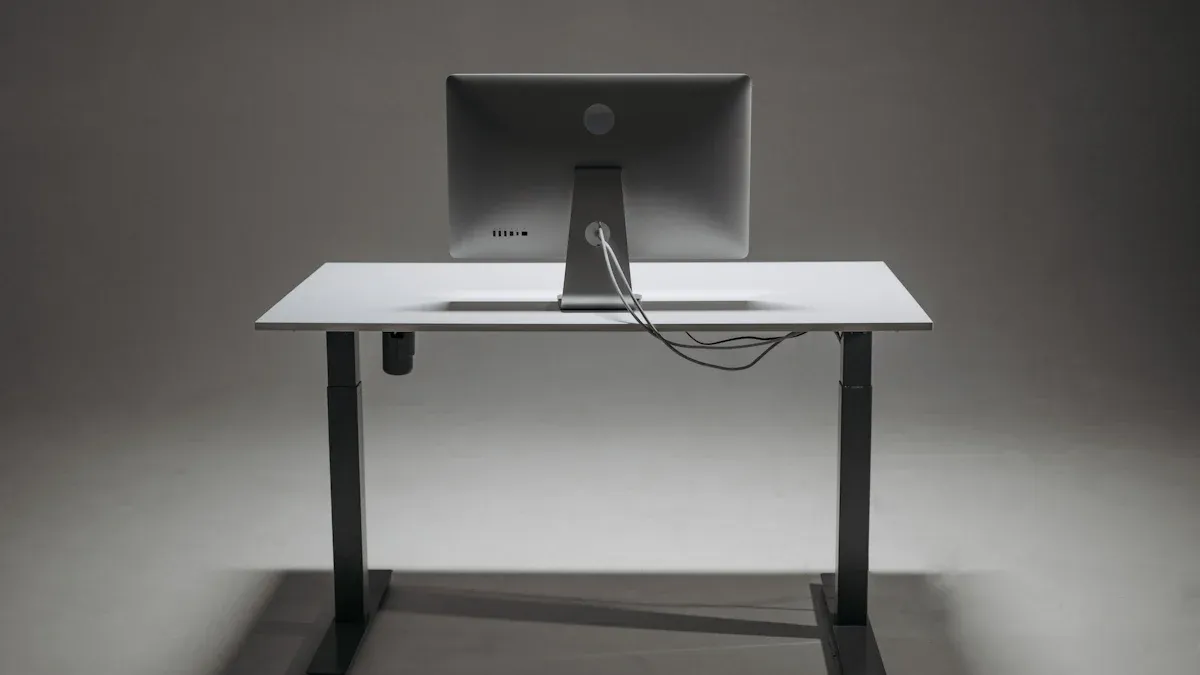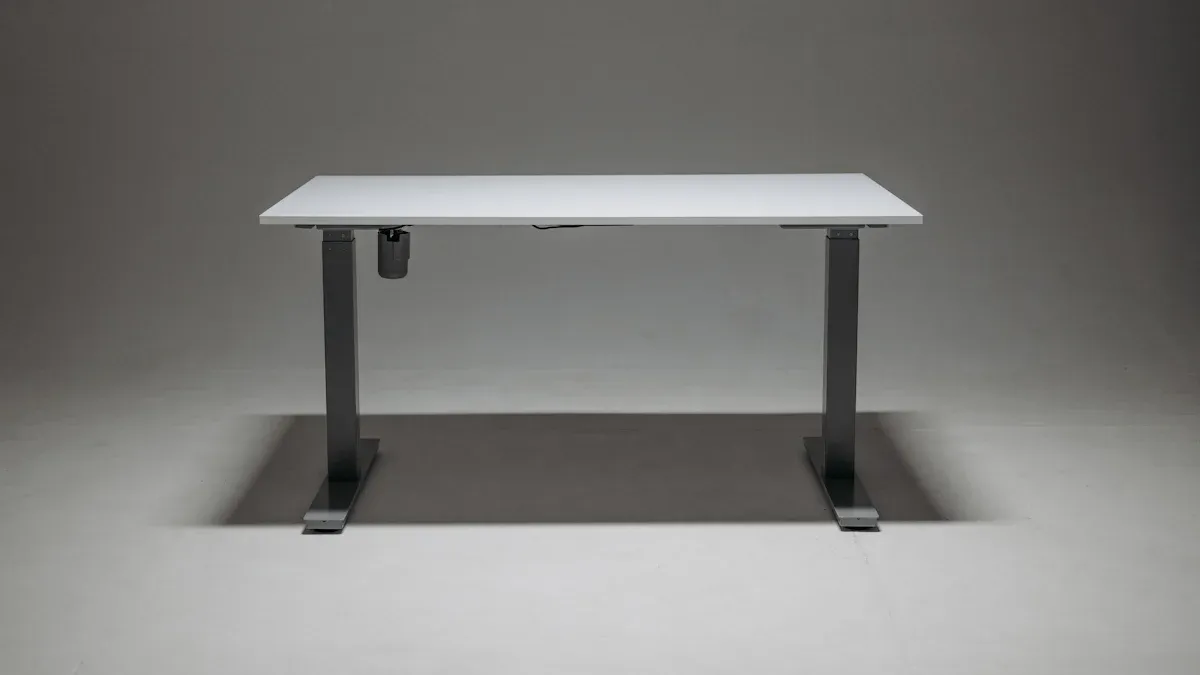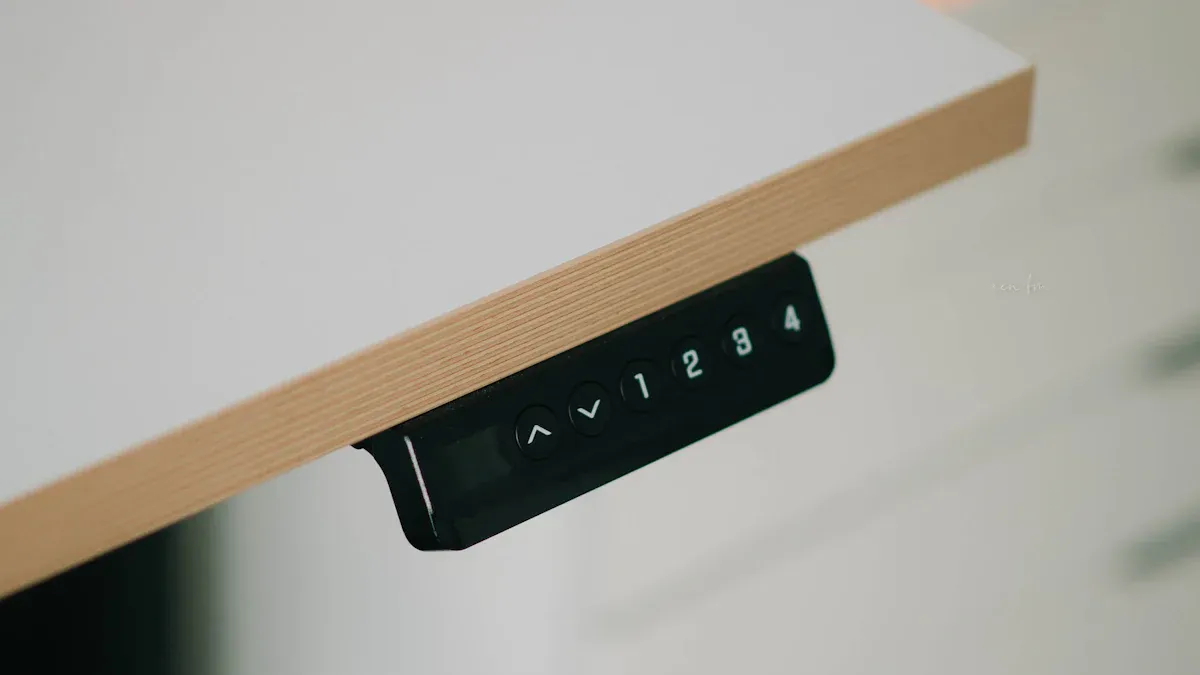
Adjusting your pneumatic desk doesn’t have to be complicated. Whether you’re sitting or standing, finding the right height can make a big difference in how comfortable and productive you feel. With just a few simple steps, you’ll have your desk set up perfectly in no time.
If you’ve recently purchased a china pneumatic desk or a Pneumatic Sit-Stand Desk, you’re in for a treat. These desks are designed to make height adjustments smooth and effortless. Let’s get started!
Key Takeaways
- Locate the adjustment lever under your desk. It’s usually on the right or left side. This lever is key to adjusting your desk height.
- To raise or lower the desk, pull the lever and guide the desktop gently. Aim for a height where your elbows form a 90-degree angle when typing.
- Check the desk’s stability after adjusting. Press down on the desktop to ensure it feels solid. Tighten any loose screws if needed.
- Maintain good posture while using your desk. Keep your monitor at eye level and your wrists straight to reduce strain.
- Regularly adjust your desk to match your posture. This helps improve comfort and supports your productivity.
Step 1: Locate the Adjustment Lever on Your Pneumatic Desk

Identifying the Lever’s Position
The first thing you need to do is find the adjustment lever on your pneumatic desk. It’s usually located underneath the desktop, either on the right or left side. Take a moment to check both sides if you’re unsure. The lever is often small but easy to spot, and it might have a label or icon indicating its function.
If you’re having trouble finding it, try running your hand along the underside of the desk. You’ll feel the lever sticking out slightly. Some desks even have a recessed lever for a sleeker design, so don’t worry if it’s not immediately visible. Once you’ve located it, you’re ready to move on to the next step.
Tip: If your desk came with a manual, it might include a diagram showing the exact location of the lever.
How the Lever Activates the Pneumatic Mechanism
Now that you’ve found the lever, let’s talk about how it works. When you pull or press the lever, it activates the pneumatic mechanism inside the desk. This mechanism uses air pressure to smoothly raise or lower the desktop.
Think of it like a gas spring in a car’s trunk—it’s designed to make adjustments effortless. When you engage the lever, the pneumatic system responds by either releasing or compressing air, depending on whether you’re raising or lowering the desk.
You don’t need to apply much force. The system is built to handle the weight of the desktop and any items you’ve placed on it. Just make sure you’re holding the desk steady while adjusting to avoid sudden movements.
Note: If the desk doesn’t move smoothly, check if the weight on the desktop exceeds the recommended limit. Overloading can affect the pneumatic system’s performance.
Step 2: Adjust the Height of Your Pneumatic Desk

Raising the Desk to a Standing Position
Ready to switch to standing? Start by gripping the adjustment lever you located earlier. With one hand on the lever, use your other hand to gently guide the desktop upward. The pneumatic mechanism will do most of the work for you, so you won’t need to apply much force.
As the desk rises, stop at a height where your elbows form a 90-degree angle when typing. This ensures your arms stay relaxed and your wrists remain straight. If you’re using a monitor, its top edge should align with your eye level.
Tip: Keep your feet flat on the ground and your shoulders relaxed while standing. This helps maintain good posture and reduces strain.
Lowering the Desk for Sitting
When it’s time to sit, adjusting your pneumatic desk is just as easy. Pull the lever again, but this time, apply slight downward pressure on the desktop. The pneumatic system will smoothly lower the desk to your desired height.
Aim for a position where your thighs are parallel to the floor and your feet rest comfortably on the ground. Your elbows should still form that 90-degree angle when typing. If you’re using a chair with adjustable height, tweak it to match the desk’s position for maximum comfort.
Note: Avoid leaning on the desk while lowering it. This can disrupt the balance and make the adjustment less smooth.
Weight Considerations for Smooth Adjustment
Your pneumatic desk is designed to handle a reasonable amount of weight, but overloading it can affect its performance. If you notice the desk struggling to move or jerking during adjustments, check the weight on the desktop.
Keep heavy items like monitors, books, or decor to a minimum. Most pneumatic desks have a weight limit listed in the manual. Staying within this limit ensures the mechanism works efficiently and lasts longer.
Pro Tip: If you frequently use heavy equipment, consider redistributing the weight or removing some items before adjusting the desk. This makes the process smoother and protects the pneumatic system.
Step 3: Test and Secure the Desk’s Position
Checking for Stability After Adjustment
Once you’ve adjusted your pneumatic desk to the desired height, it’s time to check its stability. Gently press down on the desktop with both hands. Does it feel solid, or does it wobble? A stable desk ensures your equipment stays safe and prevents distractions while you work.
If you notice any movement, inspect the desk’s base. Make sure all screws and bolts are tightened. Some desks come with adjustable feet to help level them on uneven floors. If yours has this feature, tweak the feet until the desk feels steady.
Tip: Place your desk on a flat surface for the best results. Rugs or uneven flooring can sometimes cause instability.
Ensuring Ergonomic Comfort
Now that your desk is stable, double-check its height for ergonomic comfort. When sitting, your elbows should form a 90-degree angle, and your feet should rest flat on the floor. For standing, keep your monitor at eye level and your wrists straight while typing.
Take a moment to assess your posture. Are your shoulders relaxed? Is your neck aligned with your spine? Small adjustments can make a big difference in reducing strain and improving your comfort throughout the day.
Pro Tip: Use an anti-fatigue mat when standing to reduce pressure on your feet and legs.
Troubleshooting Issues with the Pneumatic Mechanism
If your pneumatic desk isn’t adjusting smoothly, don’t panic. Start by checking the weight on the desktop. Too much weight can strain the pneumatic mechanism. Remove heavy items and try again.
Still having trouble? Inspect the adjustment lever. Sometimes, debris or wear can affect its function. Clean the lever and test it again. If the issue persists, consult your desk’s manual or contact the manufacturer for support.
Note: Regular maintenance, like cleaning and checking for loose parts, can extend the life of your desk.
Adjusting your pneumatic desk is quick and easy. Just follow these three steps: locate the lever, set the height, and test for stability. With this simple process, you can switch between sitting and standing positions effortlessly.
Tip: Regularly adjust your desk to match your posture. It helps you stay comfortable and keeps your workspace ergonomic.
By taking a few moments to fine-tune your desk, you’ll create a setup that supports your productivity and well-being every day.
FAQ
How do I know if my pneumatic desk is adjusted to the right height?
Check your posture. When sitting, your elbows should form a 90-degree angle, and your feet should rest flat on the floor. For standing, keep your monitor at eye level and your wrists straight. Adjust until you feel comfortable.
Tip: Use a mirror to check your posture while adjusting the desk.
Can I adjust my pneumatic desk while it’s loaded with items?
Yes, but keep the weight within the desk’s limit. Heavy items can make adjustments harder or strain the pneumatic system. If the desk struggles to move, remove some items and try again.
Note: Check your desk’s manual for the recommended weight capacity.
What should I do if my desk doesn’t move smoothly?
Start by checking the weight on the desktop. If it’s not overloaded, inspect the adjustment lever for debris or wear. Clean it and test again. If the issue persists, contact the manufacturer for support.
Pro Tip: Regular maintenance keeps your desk functioning like new.
Is it safe to adjust the desk while standing?
Absolutely! Just hold the desktop steady while pulling the lever. The pneumatic system is designed for smooth adjustments. Avoid leaning on the desk during the process to prevent sudden movements.
Reminder: Always keep your hands clear of pinch points during adjustments.
Can I use a pneumatic desk on uneven floors?
Yes, but you might need to adjust the desk’s feet for stability. Many pneumatic desks have adjustable feet to help level them. Place the desk on a flat surface whenever possible for the best results.
Tip: Use a rug or mat to stabilize the desk on uneven floors.
Post time: Jun-03-2025
